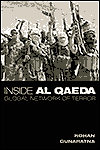|
| Home | About Kashmir Herald | |
Volume 3, No. 5 - October 2003 |
|
| Featured Article |
|
|
|
Hindu Money In India Co-opted for Islam Vinod Kumar The revelations in Sandhya Jain's article " Nationalization of the Hindu temple" (Pioneer, Oct 7, 2003) about using money from Hindu temples for Madarasas development and Haj subsidy (and churches development) are no doubt disturbing but are they a surprise? Not really. May be to a certain extent but is this a new phenomenon? It is true, as Ms. Jain writes that these monotheistic creeds are not only at variance with Hindu dharma, but their very raison d'etre is expansion by the eradication of Hindu dharma and culture. It is a classic example of one digging one's own grave -- to put it in simple language that a common man can understand. Having said that, why are these revelations not surprising or not new? Not many Hindus realize that ever since Islam appeared on the Indian subcontinent, Hindu money has been used to support Islam. At times not only in India but abroad too. When Islam first appeared on the West coast of India, Hindu kings gave grants of land and villages to the new Muslims to build their mosques, practice and preach Islam. There is no example of any Muslim king ever giving such grants to the followers of other religions and specially to the Hindus. When Islam came to India as a victor with Muhammad bin Kasim, Hindu temples and treasuries were plundered to fill the treasury of Islam in Baghdad. The loot was several times what was spent on the military expedition to conquer Sindh. But if once a temple is plundered and destroyed, it is no longer a source of revenue. So when it was realized that the famous temple at Multan was a popular place of pilgrimage and source of great revenue, contrary to common practice of temple demolition, it was left standing. But to prove his Islamic credentials and to send unmistakable message as to who was the King, a piece of cow's flesh was hung from the deity's neck. The wealth from the Hindu temples and taxes to the extent of 50% of produce continued to support the Muslim conquerors and rulers. The Hindu wealth attracted wave after wave of Muslims from all across what is today known as Middle East and Central Asia. Muslim chroniclers like Ibn Batuta and others have left vivid accounts of such migrations and how Muslim immigrants were offered highest paying jobs at the Muslim courts and in the Muslim army of Indian Muslim rulers. Generous and regular grants were also sent to foreign Muslims rulers and Islam's Holy places. Let us not harp upon the past and jump to the present times. In the last century: In Hyderabad, the princely state of Nizam, 80% of the state's land was owned by the Hindus and from 95 - 97% of state revenue was derived from the Hindus. Hindus were overtaxed. And how was this revenue spent: During the 1930s the Ecclesiastical Dept. spent an annual average of Rs. 300,000 on Islamic charities, Rs. 15,000 on Christian charities and Rs. 3000 on Hindus charities. Other large sums were expended on Islamic institutions abroad. Between
1926 and 1932 RS. 10,000,000 was given to Aligarh University, Rs.
500,000 to London Mosque, Rs. 100,000 to Jama masjid in Delhi, Rs.
100,000 to a mosque in Palestine, Rs. 80,000 to a Muslim association in
Turkey, and Rs. 232,000 to the travelling expenses of Muslims going to
Mecca. |
 |
 |
 |
|
|
Archives
| Privacy Policy |
Copyrights
|
Contact
Us | |
||